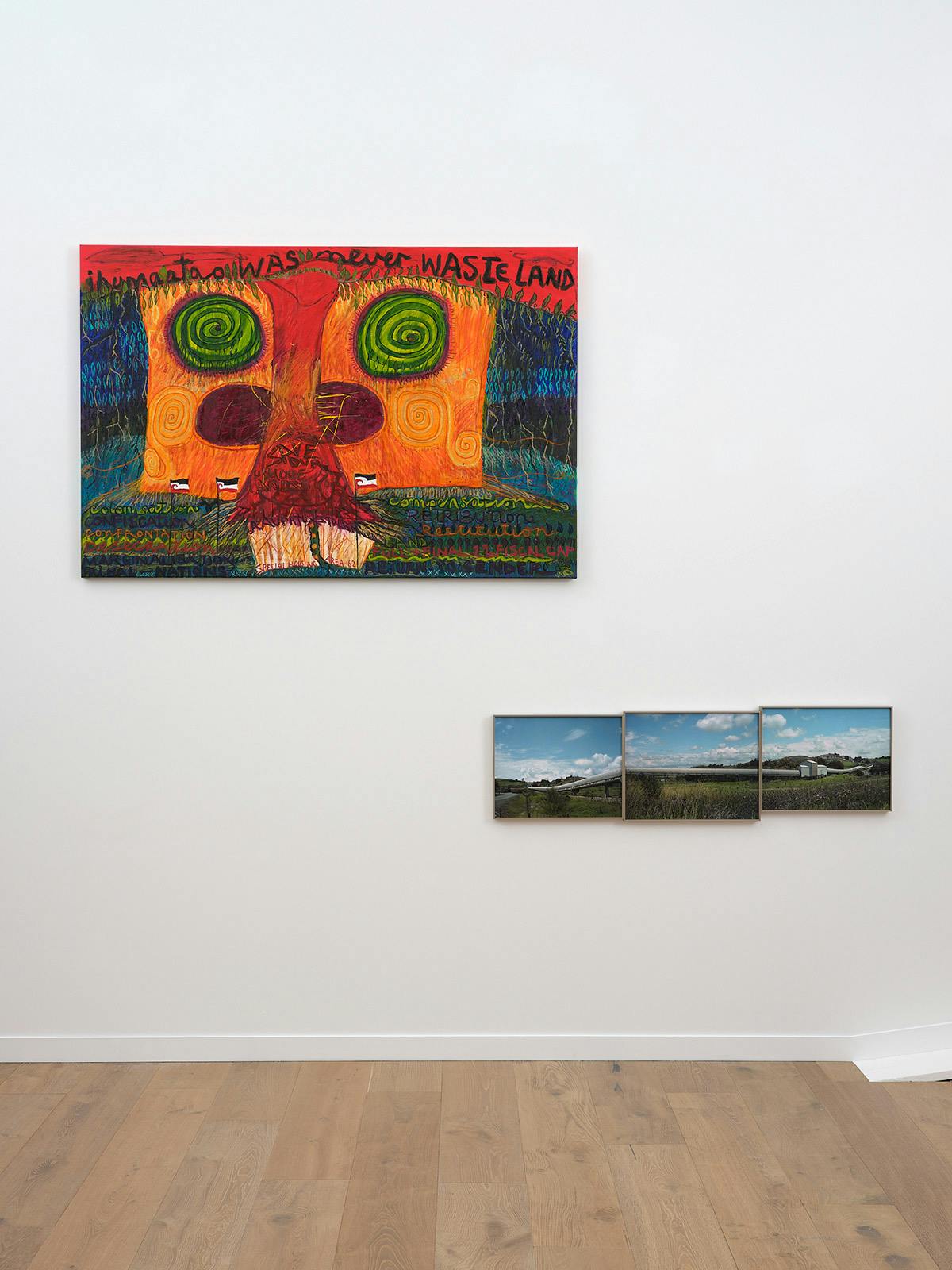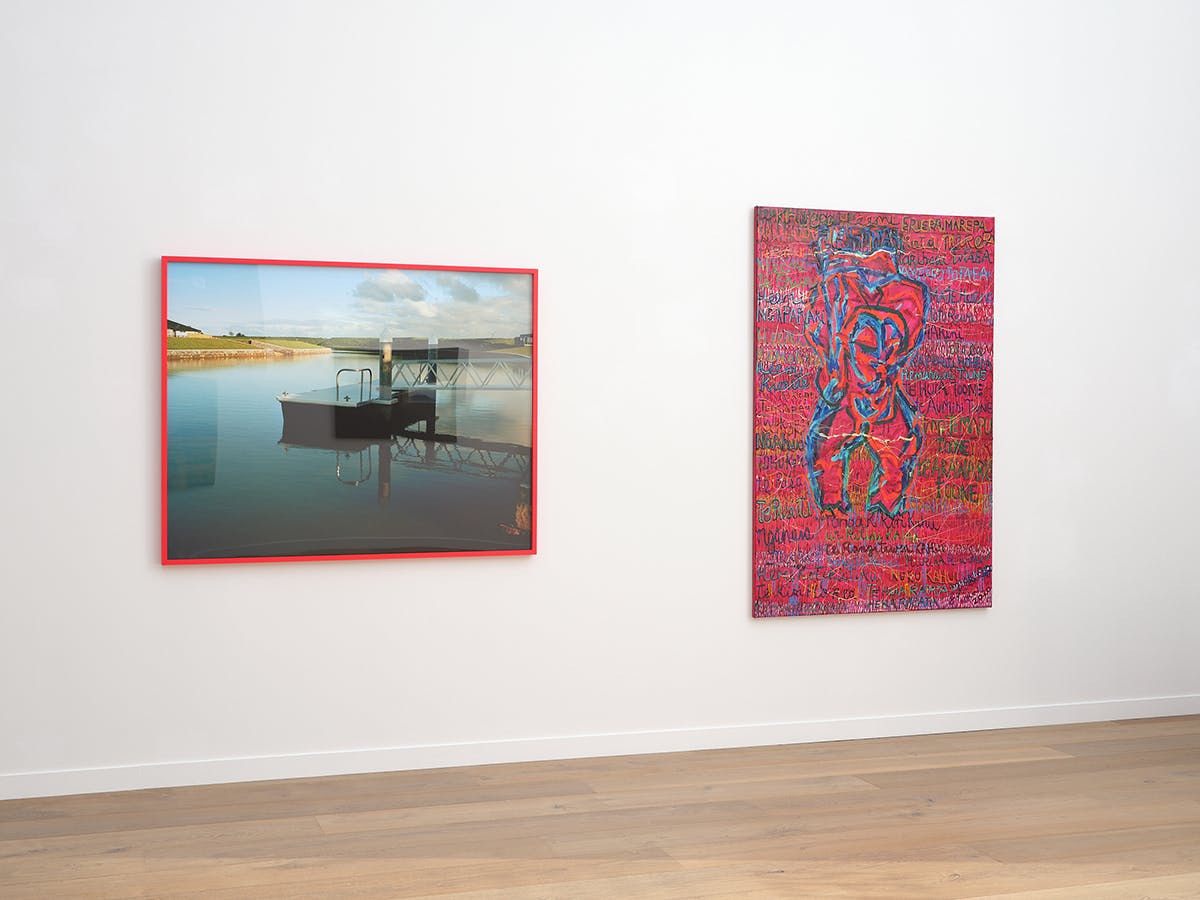
Emily Karaka and Ngahuia Harrison, Explicit (installation view), 2022, photograph by Samuel Hartnett.
Photo Credit

Emily Karaka and Ngahuia Harrison, Explicit (installation view), 2022, photograph by Samuel Hartnett.
Photo Credit

Emily Karaka and Ngahuia Harrison, Explicit (installation view), 2022, photograph by Samuel Hartnett.
Photo Credit

Emily Karaka and Ngahuia Harrison, Explicit (installation view), 2022, photograph by Samuel Hartnett.
Photo Credit
Season 2, the second exhibition series from contemporary art gallery Season, begins with Explicit by Emily Karaka and Ngahuia Harrison. Both artists are strong advocates for their iwi, and both extend their advocacy directly into their art practices. Their works are openhearted and frank, addressing complex relationships, such as those between people and place, between the Crown and mana whenua, and between greed and community good.
EMILY KARAKA
I am a descendant of Te Arawaru Toone. Te Ahiwaru are mana whenua at Ihumātao. The laws and historical confiscations of lands enacted by the Crown at Ihumātao are the root cause of a well-known series of protests. I have made a number of works about Ihumātao. Six were presented at the 22nd Biennale of Sydney, NIRIN, in 2020.
It was important to me to take the stories of Ihumātao to the world. The situation was complicated, so much so that it was necessary for the Māori King, Tūheitia Pōtatau Te Wherowhero, to mediate. We all knew the immense mana of the King would bring the stability needed in the volatile situation.
For Explicit, two works from NIRIN are presented alongside paintings from my 2015 Settlement series. The Settlement works respond to land claims, confiscations, and Treaty settlement processes in Tāmaki Makaurau, where I have lived all my life, and the Tāmaki Makaurau Collective Redress Deed, which provides collective redress for the thirteen iwi and hapū of Ngā Mana Whenua o Tāmaki Makaurau, referred to as the Tāmaki Collective.
Treaty claims, land issues, and kaitiakitanga have formed the core of my work for many years. The fourteen Tūpuna Maunga named in the Collective Redress Deed are central to another exhibition of mine, Matariki Ring of Fire, currently on show at Te Uru Waitākere Contemporary Gallery, which underscores the depth of the whakapapa ties within this city.
NGAHUIA HARRISON
Coastal Cannibals has come out of my doctoral research. I began looking at the effects of the Marine and
Coastal Area (Takutai Moana) Act 2011 upon my iwi, Ngātiwai. The research has morphed into looking at everything that falls outside of the narrow definition the Crown has created to tell Māori how we relate to the sea and coastline. As well as all of the fronts we fight on to protect not only our relationship to the moana, but the moana itself.
I’ve been working on Coastal Cannibals for the past three years and I’m constantly adding to it. The series focuses on the Whangārei Harbour, Whangārei Te Rerenga Parāoa, and the heavy industry established on and around the place, including residential housing developments. The heavy industry are places like the oil refinery, the Portland cement works, the Limestone works, the marinas—all these things gobbling up our environment and our moana.
Some of the residential developments around Ruakākā and Marsden Point have carved out the land to channel the moana, creating canals so people can have their own jetty to park their boats like they park their cars. For coastal and ocean tribes, the moana is an important and significant place—the ocean is everything. To see it being used in this way is very frustrating—it’s taking and using our land in a way that assumes our interests have been extinguished. They haven’t.
(Adapted from a 2021 interview with Objectspace, Tāmaki Makaurau.)
Season 2, the second exhibition series from contemporary art gallery Season, begins with Explicit by Emily Karaka and Ngahuia Harrison. Both artists are strong advocates for their iwi, and both extend their advocacy directly into their art practices. Their works are openhearted and frank, addressing complex relationships, such as those between people and place, between the Crown and mana whenua, and between greed and community good.
EMILY KARAKA
I am a descendant of Te Arawaru Toone. Te Ahiwaru are mana whenua at Ihumātao. The laws and historical confiscations of lands enacted by the Crown at Ihumātao are the root cause of a well-known series of protests. I have made a number of works about Ihumātao. Six were presented at the 22nd Biennale of Sydney, NIRIN, in 2020.
It was important to me to take the stories of Ihumātao to the world. The situation was complicated, so much so that it was necessary for the Māori King, Tūheitia Pōtatau Te Wherowhero, to mediate. We all knew the immense mana of the King would bring the stability needed in the volatile situation.
For Explicit, two works from NIRIN are presented alongside paintings from my 2015 Settlement series. The Settlement works respond to land claims, confiscations, and Treaty settlement processes in Tāmaki Makaurau, where I have lived all my life, and the Tāmaki Makaurau Collective Redress Deed, which provides collective redress for the thirteen iwi and hapū of Ngā Mana Whenua o Tāmaki Makaurau, referred to as the Tāmaki Collective.
Treaty claims, land issues, and kaitiakitanga have formed the core of my work for many years. The fourteen Tūpuna Maunga named in the Collective Redress Deed are central to another exhibition of mine, Matariki Ring of Fire, currently on show at Te Uru Waitākere Contemporary Gallery, which underscores the depth of the whakapapa ties within this city.
NGAHUIA HARRISON
Coastal Cannibals has come out of my doctoral research. I began looking at the effects of the Marine and
Coastal Area (Takutai Moana) Act 2011 upon my iwi, Ngātiwai. The research has morphed into looking at everything that falls outside of the narrow definition the Crown has created to tell Māori how we relate to the sea and coastline. As well as all of the fronts we fight on to protect not only our relationship to the moana, but the moana itself.
I’ve been working on Coastal Cannibals for the past three years and I’m constantly adding to it. The series focuses on the Whangārei Harbour, Whangārei Te Rerenga Parāoa, and the heavy industry established on and around the place, including residential housing developments. The heavy industry are places like the oil refinery, the Portland cement works, the Limestone works, the marinas—all these things gobbling up our environment and our moana.
Some of the residential developments around Ruakākā and Marsden Point have carved out the land to channel the moana, creating canals so people can have their own jetty to park their boats like they park their cars. For coastal and ocean tribes, the moana is an important and significant place—the ocean is everything. To see it being used in this way is very frustrating—it’s taking and using our land in a way that assumes our interests have been extinguished. They haven’t.
(Adapted from a 2021 interview with Objectspace, Tāmaki Makaurau.)